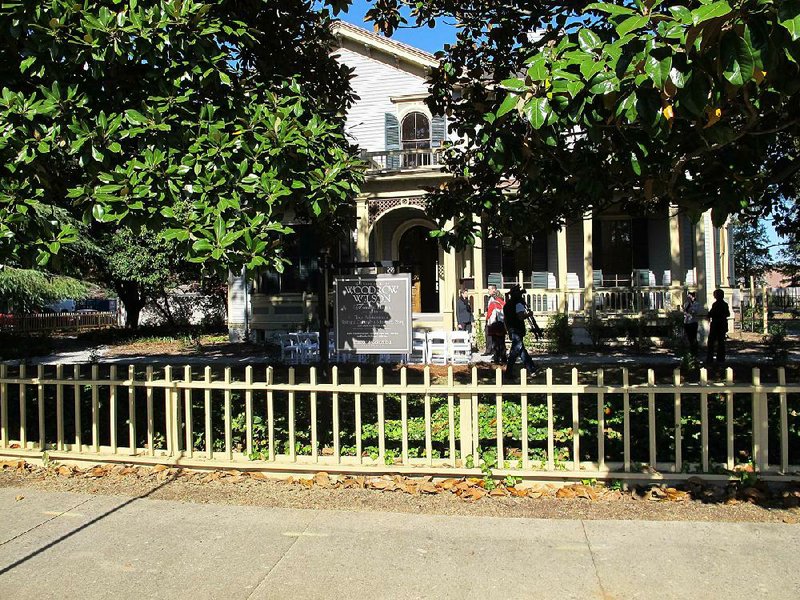COLUMBIA, S.C. - After nearly a decade of renovations, the South Carolina home where President Woodrow Wilson lived as a teenager is reopening to the public as a museum not only about the politician but also the Reconstruction Era.
The house where the 28th president of the United States moved at age 13 and spent his teenage years reopened Feb. 15.
Wilson’s father taught at the Presbyterian Theological Seminary in Columbia and was minister at First Presbyterian Church, where Wilson’s father, mother and sister are all buried.
The villa-style house built in 1871 is one of four historic sites for Wilson - along with his birthplace in Staunton, Va.; a home in Augusta, Ga., where he grew up; and the Washington house where he lived after his time as president. The South Carolina house is the state’s only presidential site.
Saved from demolition in 1928 after residents protested, the historic house in downtown Columbia closed its doors and grounds to the public in 2005 when plaster fell from the ceiling in some of the downstairs rooms and water damage to the foundation became evident.
“Rather than just start pulling out artifacts from those rooms that were affected, we decided to go ahead and close the whole site,” said John Sherrer, director of cultural resources at Historic Columbia, which maintains the property.
The $3.6 million project to restore the house, which is owned by Richland County, was funded through tax money and private donations. During the nearly decade-long closure, Historic Columbia spent that time doing a historic analysis, which determined details like the blueprint of the home when the Wilsons lived in it and what had been added and closed up in the decades since.
“The end result was a building that, structurally, looked like it did when the Wilsons called this home,” Sherrer said. “If Tommy Wilson [Woodrow’s nickname] and his family had showed up here in 2005, they’d be walking around going, ‘What’s that window doing there?’ or ‘How can we get from this room to that room?’ … Now what we have is a building that more genuinely reflects what they would have been accustomed to.”
The house also now has a new roof, shutters and a wood foundation that needed to be replaced because of water damage. The project also included a revamping of the exterior paint scheme, which Sherrer says is now closer to what it would have been when Wilson lived there and is being replicated by preservationists working on other Columbia-area buildings from the same era. Once painted white and gray, now the house’s outside is cast in more vibrant but still earthy tones, with tan and brown trim and deep blue-green shutters.
“It’s exciting because this is a building that is important in its own right, but it’s magnified when people use it as kind of a historic preservation laboratory, and in so doing, they can apply those thoughts to their own properties,” he said.
Visitors to the Wilson home will see not only some pieces that are original to the property - including the family bed on which Wilson was born - but also reproductions from the era, like a desk that historians say is similar to one Wilson would have used as a teen. There are also reproductions of Reconstruction Era light fixtures throughout the home, and high-tech exhibits that allow visitors to virtually stroll through a map of 1920s Columbia, using their fingers to bring up information on sites around the city.
Exhibits detail Wilson’s personal life and the Reconstruction era, when the family lived in Columbia. During the tumultuous time that followed the Civil War, federal troops lingered throughout the South, and the federal government exerted its power over affairs in the state, which had been the first to secede from the union. Blacks began voting and were elected to political office, and the era also saw the rise of white radical groups that sought to drive them out.
Other exhibits focus on Wilson’s presidency, which included passage of the Federal Reserve Act and World War I.
Outside, the grounds include several outbuildings that can be used for special events and magnolia trees planted there by Wilson’s mother.
“It’s one thing to have a restored building. Everybody loves a restored building,” Sherrer said. “It’s another thing to have a restored building within an accurate and beautiful setting, and that’s what this is intended to be about.”
WOODROW WILSON FAMILY HOME: 1705 Hampton St., Columbia, S.C.; tinyurl.com/oeupota; (803) 252-7742.
Travel, Pages 52 on 03/23/2014

